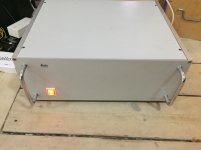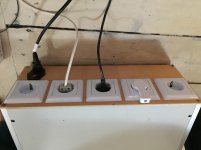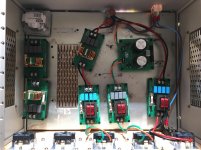I’ve rescued this old Leitz power supply from a container at work, it was used to power some kind of scientific equipment. Something had leaked inside of it, so I’ve gotten rid of all (weird!) stuff that was inside.
I’m now building a power cleaner out of it instead, and since I'm a complete beginner I could use some comments and help
Inside it I now have a number of FO-felix’es. For a little bit of experimenting I’ve set them up differently; the ones with red coils I believe are 3A max (220v), the ones with copper coils are 18A max. The one with ATL written on it is a DC blocker, apparently potentially useful when used with a transformer. 2 of the boards are in line for mounting.
The big challenge I have is that I don’t have and cannot get earth in my apartment. All power outlets are only 2 wires 220v, phase and neutral. Naturally the chassis therefore cannot be earthed either.
All the pcb’s are fitted with nylon stand offs, but they are not yet screwed to the bottom of the enclosure.
I’ve fitted an IEC inlet with a fuse, and every FO-felix also has a fuse (after I bought all parts I’ve come to realize that I can’t even draw 18A from my outlets, so I could have used coils with lower rating but better supression of noise. And the 18A fuses seems to be redundant, as the mains fuse in my apartment would blow before these).
Does it look ok safety wise? Or am I lucky to be alive? Any tips or anything I should pay special attention to? Would safety be better if I used wood for the floor too?
Thanks !



I’m now building a power cleaner out of it instead, and since I'm a complete beginner I could use some comments and help
Inside it I now have a number of FO-felix’es. For a little bit of experimenting I’ve set them up differently; the ones with red coils I believe are 3A max (220v), the ones with copper coils are 18A max. The one with ATL written on it is a DC blocker, apparently potentially useful when used with a transformer. 2 of the boards are in line for mounting.
The big challenge I have is that I don’t have and cannot get earth in my apartment. All power outlets are only 2 wires 220v, phase and neutral. Naturally the chassis therefore cannot be earthed either.
All the pcb’s are fitted with nylon stand offs, but they are not yet screwed to the bottom of the enclosure.
I’ve fitted an IEC inlet with a fuse, and every FO-felix also has a fuse (after I bought all parts I’ve come to realize that I can’t even draw 18A from my outlets, so I could have used coils with lower rating but better supression of noise. And the 18A fuses seems to be redundant, as the mains fuse in my apartment would blow before these).
Does it look ok safety wise? Or am I lucky to be alive? Any tips or anything I should pay special attention to? Would safety be better if I used wood for the floor too?
Thanks !



Thanks, I think I will leave them there now they are there though.The green core CMC's don't need fuses.
My biggest question is: what will the consequences be in this setup (with no earth), if that awful error happens which is the whole reason for having an earthed connection?
The chassis could become live and stay live, the same cannot be said for someone who may then touch it.
Thanks, that is exactly my worry.
However, I am yet not convinced it is a problem.
In Denmark new buildings have earth, but it is not required in older buildings. In Copenhagen most buildings are old and therefore don't have PE. I live on the 5th floor in an old brick/wood building. As I understand that, me touching the phase would not be a problem as I am "floating". What is required by law is to have an "HPFI" switch installed (RCCB in english), which will cut all power to the apartment if the amperes exiting is not equal to the amperes entering (as I understand it). It is required that it cuts all power if the difference mentioned is > 30mA and it should do so within 0.3s. Those limits have apparently been chosen since 50mA is enough to cause a hearth attack.
So, as I understand it, even if I am not floating on the 5th floor, and the case becomes live and the power can find a way to earth, the RCCB switch will cut everything off in 0.3s and hopefully save me. This is said to be very unpleasant but normally not life threatening.
Am I wrong in assuming this?
The real risk seems to me to be touching both the phase and 0 at the same time, as that will not be detected by the RCCB switch.
If there is not PE then you have to build it like class II isolated device. DIY wise, that would mean a wooden box to start with. The rest of your audio gear should be built the same way. I don't know how is your filter designed, but in case it has capacitors from live and neutral to PE to shunt common mode noise to ground, then in the absence of PE and if the devices that follow have a ground connection with the filter, the leakage current of the mentioned caps will flow trough the user. And I can see your are using several filters that will add their leakage current. So, a wooden box without PE connection to the outlets and perhaps only one filter to feed them all.
In the US new manufacturing has to be "double insulated" to be 2 prong. It's probably close to the same as class II isolated device but I know you don't have to avoid metal, entirely.
There are no Y caps in it that. Use all the filters you want. The COMOCO ones will do the most without safety ground.
There are no Y caps in it that. Use all the filters you want. The COMOCO ones will do the most without safety ground.
...In Copenhagen most buildings are old and therefore don't have PE. I live on the 5th floor in an old brick/wood building. As I understand that, me touching the phase would not be a problem as I am "floating". ...
Grab the water pipe, steam pipe, electrical conduit. Traditionally these are hard-bonded to dirt. Grab the wrong side of the AC line with your other hand. This has been a 'popular' way to get a shock. Radio near sink or bathtub.
Yes, *newer* buildings may be a lot of plastic for water, power, even heating. I have got most copper water-pipe out of my house, but not every last bit. I do not install new metal electrical conduit, but I MUST bond metal electrical boxes to building ground (if available; you might not have this).
And some US wiring is still no-ground. I have a 1948 house nearly all original 2-wire no-ground. Ironically it has an excellent dirt-rod installation (for this area). I'll be re-wiring 99% of it; I believe in good grounds for many reasons.
I have tripped a GFI(RCCB,HPFI) standing on concrete. It was a non-event. I touched, it clacked, the saw would not run until I reset. (US GFIs are nominal "5mA" but I am suspecting the "30mA" UK/EU breakers use the same time-curve but cite a different time-point, to differentiate people-savers from machine-savers.)
If you truly can not reach "dirt" from your room, and won't take your hi-fi in the tub, and have GFI protection, I see no problem with what you have done.
I have tripped a GFI(RCCB,HPFI) standing on concrete. It was a non-event. I touched, it clacked, the saw would not run until I reset. (US GFIs are nominal "5mA" but I am suspecting the "30mA" UK/EU breakers use the same time-curve but cite a different time-point, to differentiate people-savers from machine-savers.)
could you comment on the severeness of the electrical shock pls?
Hi I am afraid that class2 or double insulated are undoable for DIY as there are not many ways for a DIYer to test if things are done correctly. If you have metal (copper) water piping in the house these will normally connected to PE but make sure they are. There are clamps for PE connection to waterpiping (here these were used in bath rooms) but you have to follow local regulations on this subject. Otherwise I don't see an easy solution except for also using heat shrink tube and insulated AMP connectors etc. Use 4 standoffs for the PCB's and mount everything as it should be: mechanically 100% and at safe distances from side panels, bottom panel etc. Fine craftmanship will help ;-)
RCCB are fine devices but normally they are combined with PE for optimal safety. If there is absolutely no PE then there is not much you can do. Please also understand that net filters and 3 prong devices with SMPS will need a "path" to PE for getting rid of noise.
An isolation transformer will work but it won't solve the point that many devices use PE as "path" for filtering HF/RF...
* You make a mistake by using the PE version of the Schüko wall socket and IEC inlet with PE pin when there is no PE! You should use the non-PE version for both ingoing and outgoing connections. In the current situation please think what will happen when a connected PE device with supplied PE IEC cable has a short from L to PE... It will cause mains voltage to be at the PE pin. If you completely avoid using a connection to the case to the input PE of the IEC connector you get away with it but still it would be good practice to use PE wall outlets when PE is around and 2 prong versions when there is no PE.
RCCB are fine devices but normally they are combined with PE for optimal safety. If there is absolutely no PE then there is not much you can do. Please also understand that net filters and 3 prong devices with SMPS will need a "path" to PE for getting rid of noise.
An isolation transformer will work but it won't solve the point that many devices use PE as "path" for filtering HF/RF...
* You make a mistake by using the PE version of the Schüko wall socket and IEC inlet with PE pin when there is no PE! You should use the non-PE version for both ingoing and outgoing connections. In the current situation please think what will happen when a connected PE device with supplied PE IEC cable has a short from L to PE... It will cause mains voltage to be at the PE pin. If you completely avoid using a connection to the case to the input PE of the IEC connector you get away with it but still it would be good practice to use PE wall outlets when PE is around and 2 prong versions when there is no PE.
Last edited:
Thanks, I don't understand what above means though. I have no 3-pin cables at all, all my devices have 2 pins only. The cable going to the IEC inlet has a 2-pin at the other end too. And the earth pins of the schukos are not connected to the chassis, would that not also be a requirement for things to go bananas?* You make a mistake by using the PE version of the Schüko wall socket and IEC inlet with PE pin when there is no PE! You should use the non-PE version for both ingoing and outgoing connections. In the current situation please think what will happen when a connected PE device with supplied PE IEC cable has a short from L to PE... It will make your box live!
Yes I corrected my text. If you now would have connected the case to the PE pin of the IEC inlet and the wall sockets then things would indeed be more dangerous.
If you don't have 3 pin cables at all then you certainly have used the wrong Schüko wall outlets as these are meant for PE cables. I know, it is curious why 2 prong connectors can be used in PE wall sockets but generally these are used for double insulated devices. Things change when 3 conductor cables are used as the aforementioned situation can occur. Here it is even forbidden to use PE sockets when no PE is available.
Please note that the Danish Schüko type K system is different from other European Schüko versions although things have been somewhat harmonized since 2008. I am not the one that knows in depth what the current Danish electrical regulations are. It is better to ask a local qualified electrician for reliable information.
Museum of Plugs and Sockets: plugs sockets in Europe
If you don't have 3 pin cables at all then you certainly have used the wrong Schüko wall outlets as these are meant for PE cables. I know, it is curious why 2 prong connectors can be used in PE wall sockets but generally these are used for double insulated devices. Things change when 3 conductor cables are used as the aforementioned situation can occur. Here it is even forbidden to use PE sockets when no PE is available.
Please note that the Danish Schüko type K system is different from other European Schüko versions although things have been somewhat harmonized since 2008. I am not the one that knows in depth what the current Danish electrical regulations are. It is better to ask a local qualified electrician for reliable information.
Museum of Plugs and Sockets: plugs sockets in Europe
Last edited:
RCCB are fine devices but normally they are combined with PE for optimal safety. If there is absolutely no PE then there is not much you can do. Please also understand that net filters and 3 prong devices with SMPS will need a "path" to PE for getting rid of noise.
That was a problem before building anything. SMPS 3 prong are not meant to be used in old places... And they have their own filters so it is not as if he created a new situation.
I've used german schukos, to add a further bit of confusion to this whole miseryPlease note that the Danish Schüko type K system is different from other European Schüko versions. I am not the one that knows in depth how Danish electrical regulations are. It is better to ask a local qualified electrician what the possibilities are.
Museum of Plugs and Sockets: plugs sockets in Europe
Edit: I see there are some differences with the grounding, yes
Last edited:
Danmark had a different Schüko system because a local state owned company had the monopoly on producing stuff in the past. That is why thicker pins were chosen. What could go wrong ?  This caused happy German hotel owners when Danish guests arrived with electric gear with them as it ruined the German Schüko wall sockets
This caused happy German hotel owners when Danish guests arrived with electric gear with them as it ruined the German Schüko wall sockets 
French type sockets were allowed in 2008 and and standard Schüko stuff in 2011. Confusing....
Tell that to people living in old places It is still true in many cases that SMPS with a PE connection use PE as a path to filter HF/RF. Besides that: devices with 3 conductor cables that are connected to PE wall sockets with PE not connected or to 2 prong wall sockets cause the (metal) casings of the devices to have half the mains voltage on them as the caps from L and N to PE will be a voltage divider. Low current but still very unpleasant when one touches the casing.
It is still true in many cases that SMPS with a PE connection use PE as a path to filter HF/RF. Besides that: devices with 3 conductor cables that are connected to PE wall sockets with PE not connected or to 2 prong wall sockets cause the (metal) casings of the devices to have half the mains voltage on them as the caps from L and N to PE will be a voltage divider. Low current but still very unpleasant when one touches the casing.
French type sockets were allowed in 2008 and and standard Schüko stuff in 2011. Confusing....
SMPS 3 prong are not meant to be used in old places...
Tell that to people living in old places
Last edited:
Sorry  I've molested the jacks on some of my own gear (apple), with a bread knife, to make it fit a little better in the south
I've molested the jacks on some of my own gear (apple), with a bread knife, to make it fit a little better in the south 
Our old sockets are the best looking though
Our old sockets are the best looking though
An externally hosted image should be here but it was not working when we last tested it.
I don't understand where the ground would attach on the fo-felix, even if I had it?That was a problem before building anything. SMPS 3 prong are not meant to be used in old places... And they have their own filters so it is not as if he created a new situation.

- Home
- Amplifiers
- Power Supplies
- Power conditioner build